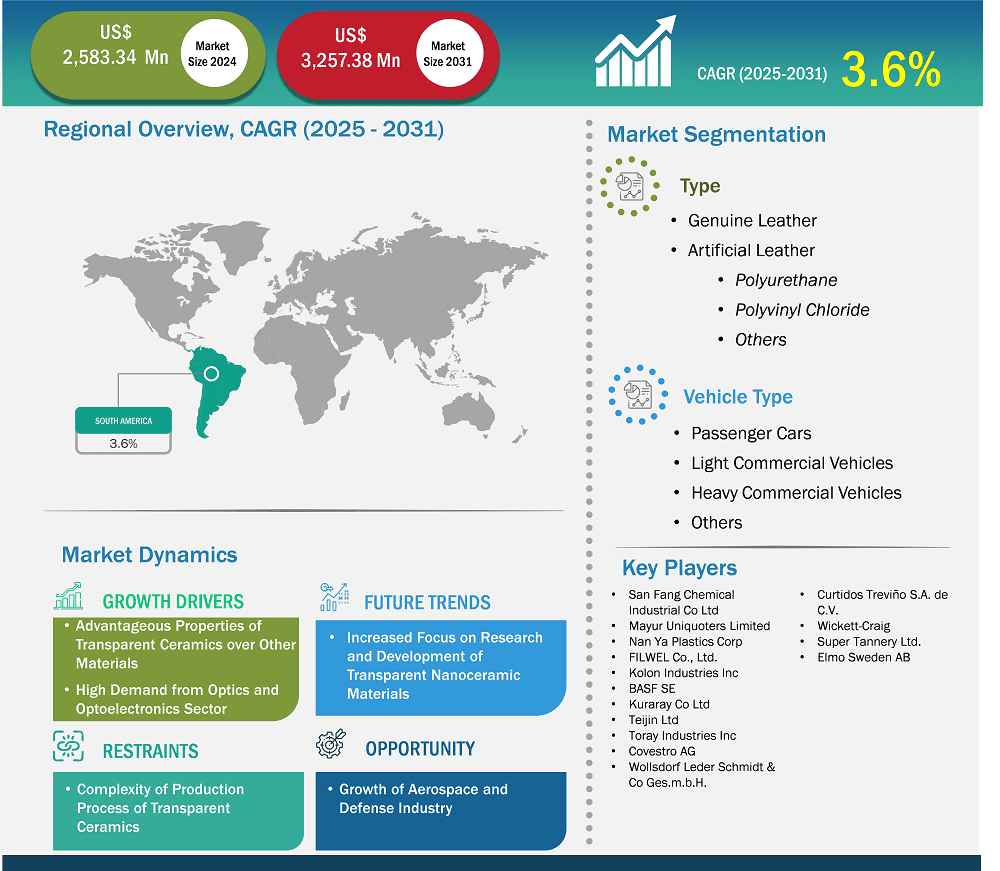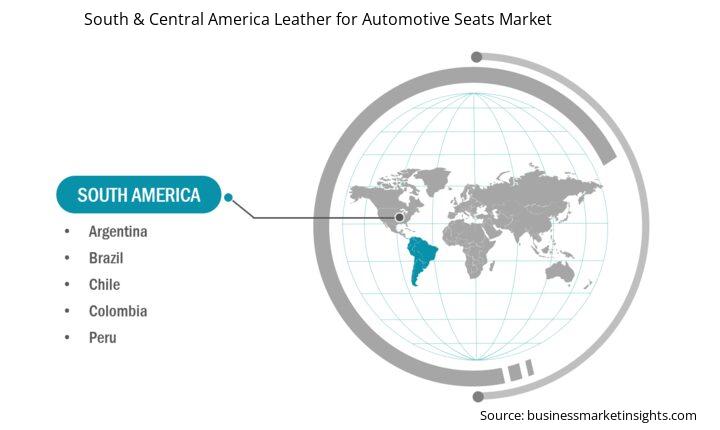South & Central America Leather for Automotive Seats Market Report (2021-2031) by Scope, Segmentation, Dynamics, and Competitive Analysis
No. of Pages: 170 | Report Code: BMIRE00032155 | Category: Chemicals and Materials
No. of Pages: 170 | Report Code: BMIRE00032155 | Category: Chemicals and Materials
The South & Central America leather for automotive seats market size is expected to reach US$ 3,257.38 million by 2031 from US$ 2,583.34 million in 2024. The market is estimated to record a CAGR of 3.6% from 2025 to 2031.
The significant presence of automotive companies in Brazil, Argentina, and Chile propels the sales of leather for automotive seat applications in South and Central America. According to the report by Fastener World Inc., sales of vehicles in Central and South America increased by 2.8% year-on-year to 3.8 million to 4.1 million units in 2024. Brazil dominates the region's sales, accounting for over half, followed by Argentina and Chile with 300,000–400,000 units each. The region's automotive industry, which relies mainly on import and export revenue generation, creates lucrative opportunities for leather for automotive seat applications. Passenger car sales growth is the prime factor driving the leather for automotive seats market.
Major manufacturers in the automotive sector have strategized the development and expansion of their operational capacities in South & Central America to benefit from the lucrative automotive market. In 2022, Audi AG invested US$ 19.2 million to restart production activities at the company's plant in Parana, Brazil, registering a capacity of 4,000 vehicles per year. The growth of passenger car sales is driven by their pricing and credit availability in the country. In 2022, Kavak invested US$ 500 million in its auto reconditioning space in Brazil to purchase and sell second-hand cars. The company already has 40 logistics centers and vehicle reconditioning spaces in Latin America. The investments in the used car industry are expected to drive the maintenance and reconditioning operations in the region. End users of leather for automotive seat applications include automotive companies and original equipment manufacturers. Thus, the growth in the automotive industry is expected to create opportunities for players operating in the leather for automotive seats market in the coming years.

Key segments that contributed to the derivation of the South & Central America leather for automotive seats market analysis are type and vehicle type.
Vegan leather has been experiencing significant demand as more industries and consumers embrace sustainable and cruelty-free alternatives to traditional leather. Vegan leather seats for automotive applications have become increasingly popular due to the use of plant-based materials. These materials include pineapple leaves, mushroom, apple peels, and others. Vegan leather provides a cruelty-free alternative to genuine leather and aims to reduce the environmental impact caused by animal agriculture. Vegan leather eliminates the need for animal byproducts, making it an ideal choice for vegan buyers.
The growing number of vegan buyers contributes to the market growth. According to YouGov and Veganuary, 25.8 million people tried veganism as of January 2025. This growing adoption results in an increased production and adoption of vegan products in various industries, including the automotive industry.
Automotive manufacturers develop vegan leather seats from plant-based materials which are processed into breathable and durable fabrics. This type of leather seat also possesses several advantageous properties. It is also resistant to stains and scratches and provides long-lasting use. Vegan car seats also benefit from regular conditioning and treatments designed for synthetic materials, which help maintain their visual appearance.
Tesla, BMW AG, Audi AG, and Mercedes-Benz are among the brands offering vegan leather car seats. In February 2024, BMW AG launched an all-electric BMW 5 Series with a completely vegan interior, including vegan seats made from vegan leather using cactus, cork, and mushroom as raw materials. Such increased use of vegan leather in automotive applications contributes to the market growth of leather for automotive seats.
Based on country, the South & Central America leather for automotive seats market comprises Brazil, Argentina, and the Rest of South & Central America. Brazil held the largest share in 2024.
Brazil is the largest country and one of the major automotive producers in South & Central America. In the past few years, the growth in passenger vehicle sales in Brazil has been driven by a combination of national economic growth, favorable consumer credit policies, and fiscal incentives from the government. According to the OICA Correspondents Survey, passenger car production in Brazil rose to 1,895,020 units in Year-to-Date (YTD) 2024, up from 1,782,079 units in YTD 2024. The same source also reports that light commercial vehicle production increased to 485,576 units in YTD 2024, compared to 421,626 units during the same period in 2024. Growing volumes of light commercial vehicle and passenger car production are driving the demand for leather seat applications, with producers concentrating on premium interiors for enhanced comfort, appearance, and consumer attraction.
According to the International Organization of Motor Vehicle Manufacturers (OICA), Brazil was the largest manufacturer and exporter of light and commercial vehicles in 2024 in South and Central America. The country reported production of 2.3 million vehicles in 2022. The expanding automotive production industry and increasing vehicle ownership in Brazil are expected to propel the demand for leather for automotive seat applications, bolstering the growth of the leather for automotive seats market in Brazil during the forecast period.
| Report Attribute | Details |
|---|---|
| Market size in 2024 | US$ 2,583.34 Million |
| Market Size by 2031 | US$ 3,257.38 Million |
| CAGR (2025 - 2031) | 3.6% |
| Historical Data | 2021-2023 |
| Forecast period | 2025-2031 |
| Segments Covered |
By Type
|
| Regions and Countries Covered | South and Central America
|
| Market leaders and key company profiles |
|
Some of the key players operating in the market include San Fang Chemical Industrial Co Ltd; Mayur Uniquoters Limited; Nan Ya Plastics Corp; FILWEL Co., Ltd.; Kolon Industries Inc; BASF SE; Kuraray Co Ltd; Teijin Ltd; Toray Industries Inc; Covestro AG; Wollsdorf Leder Schmidt & Co Ges.m.b.H.; Curtidos Treviño S.A. de C.V.; Wickett-Craig; Super Tannery Ltd.; and Elmo Sweden AB among others. These players are adopting various strategies such as expansion, product innovation, and mergers and acquisitions to provide innovative products to their consumers and increase their market share.
The following methodology has been followed for the collection and analysis of data presented in this report:
The research process begins with comprehensive secondary research, utilizing both internal and external sources to gather qualitative and quantitative data for each market. Commonly referenced secondary research sources include, but are not limited to:
Note: All financial data included in the Company Profiles section has been standardized to USD. For companies reporting in other currencies, figures have been converted to USD using the relevant exchange rates for the corresponding year.
The Insights Partners conducts a significant number of primary interviews each year with industry stakeholders and experts to validate its data analysis and gain valuable insights. These research interviews are designed to:
Primary research is conducted via email interactions and telephone interviews, encompassing various markets, categories, segments, and sub-segments across different regions. Participants typically include:

The South & Central America Leather for Automotive Seats Market is valued at US$ 2,583.34 Million in 2024, it is projected to reach US$ 3,257.38 Million by 2031.
As per our report South & Central America Leather for Automotive Seats Market, the market size is valued at US$ 2,583.34 Million in 2024, projecting it to reach US$ 3,257.38 Million by 2031. This translates to a CAGR of approximately 3.6% during the forecast period.
The South & Central America Leather for Automotive Seats Market report typically cover these key segments-
The historic period, base year, and forecast period can vary slightly depending on the specific market research report. However, for the South & Central America Leather for Automotive Seats Market report:
The South & Central America Leather for Automotive Seats Market is populated by several key players, each contributing to its growth and innovation. Some of the major players include:
The South & Central America Leather for Automotive Seats Market report is valuable for diverse stakeholders, including:
Essentially, anyone involved in or considering involvement in the South & Central America Leather for Automotive Seats Market value chain can benefit from the information contained in a comprehensive market report.